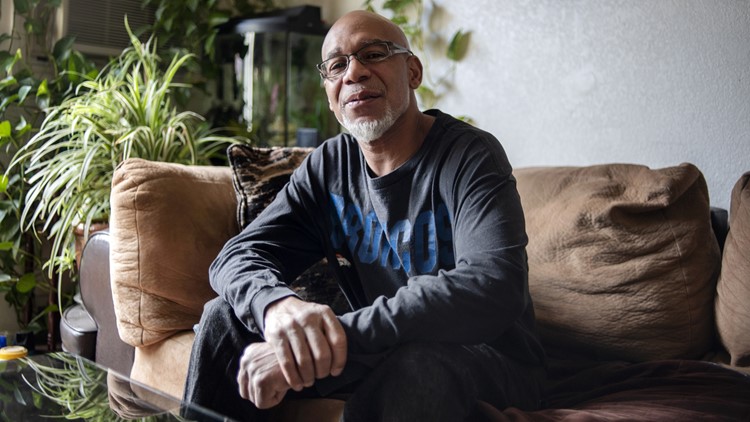LAFAYETTE, Colo. — Five years ago, Denver made a list of people most often involved with jail, detox centers and emergency rooms — and then offered them housing.
The program was so successful at keeping people in stable housing and out of jail, that the U.S. Treasury Department has offered the city more than $6 million in new federal aid, if the program can demonstrate a comparable drop in Medicare and Medicaid billings over the next seven years.
> This story is powered by COLab, the Colorado News Collaborative. 9NEWS joined this historic collaboration with more than 40 other newsrooms across Colorado to better serve the public.
If Denver can keep 125 new people stably housed by the time the project ends, it will not be required to pay back the money.
“I think we’re all very proud to see the success of this program, and frankly, to debunk this myth that people choose to be homeless, because when folks were offered the opportunity to be housed, they took it and they stayed and they made significant progress,” said Julie Smith, communications director for the city’s finance department.
The offer underscores gains made from the city’s social impact bond, a five-year initiative that began in 2016, with the goal of keeping people who were formerly homeless stably housed and out of jail.
The initial 250 participants had cost the government $7.3 million per year as they cycled through emergency services, the criminal justice system and detox centers.
The social impact bond kept so many participants stably housed and out of jail after its first year, that in 2018, city leaders pumped an additional $675,000 into the program to increase the number of participants to 325.
Now, city leaders must show investors that stable housing can also reduce Medicare and Medicaid expenses. In the next phase of the initiative, beginning on April 29, program leaders will recruit and house an additional 125 individuals who are frequently incarcerated and frequent users of the emergency health care system.
If city leaders can meet their goal of keeping all of them in stable housing, and can prove the model saves on federal health care costs, in seven years, the U.S. Treasury Department will give the city $6.4 million to help fund the initiative. The city is contributing $900,000 for the newest part of the housing initiative, and $3 million in continued support for people in the first phase of the social impact bond, who still are housed.
Denver Mayor Michael Hancock called the social impact bond a win-win, because it improved the wellbeing of people who were able to remain housed, while also reducing spending for the city.
“I look forward to seven long years with them,” Margaret Danuser, deputy chief financial officer for the city’s finance department, said of the U.S. Treasury Department.
Federal law pushes cities to improve human services
The federal Social Impact Partnerships to Pay for Results Act was signed into law in February 2018, to improve the effectiveness of certain human services. The federal government will pay for a project only if it meets certain benchmarks, according to the U.S. Treasury Department website.
In 2016, eight private investors agreed to provide $8.6 million to the social impact bond program to offer housing and other services to participants, such as linking them to mental and physical health care providers, employment support, transportation and other basic necessities.
After the program met its goals, the city paid investors $9.6 million — $4.5 million in housing stability payments, $5.1 million in jail diversionary payments, plus $1 million for the project’s success.
Investors agreed to share a portion of the $1 million payment with the two main service providers: The Colorado Coalition for the Homeless and Mental Health Center of Denver. If the program had not met its goals, the city would not have had to repay investors.
More than half of the total annual cost for each person in the social impact bond program was offset by reductions in the costs for other public services, such as jail, detox and other emergency care, according to the city.
Evaluators from the Urban Institute, a think tank based in Washington, D.C., worked with The Evaluation Center at the University of Colorado Denver to track and measure the effects of supportive housing from 2016 to 2020.
The same agencies plan to track the next phase of the program starting in April.
Tracking the effects of social impact bond initiative
Researchers found that 86% of the people involved in the program remained housed after one year, 81% were still housed after two years, and 77% remained housed after three years.
Participants also spent far fewer nights in shelters. Evaluators reported a 34% reduction in police contacts; a 40% reduction in arrests; a 30% reduction in the number of times a participant went to jail, a 27% reduction in how long participants stayed in jail; and a 65% reduction in their use of detoxification services.
Two years after joining the program, participants had a 40% decrease in emergency department visits, a 155% increase in office-based health care visits, and a 29% increase in new prescription medications when compared to those who were in a control group.
During the five years, the Colorado Coalition for the Homeless and the Mental Health Center of Denver — the two main service providers — housed 365 people.
In all, eight investors, seven partners and nine organizations took part in the social impact bond endeavor. By shifting its focus from providing costly emergency services, to offering preventive care, the city saved money in the long run, program leaders said.
“It has really confirmed everything that we as an organization have known about housing with supportive services, and that is, that it is the most effective way to house people who were experiencing homelessness — and keeps them housed,” said Cathy Alderman, chief communications and public policy officer for the Colorado Coalition for the Homeless, which provided housing to 260 participants.
“And when you make those investments, and you’re intentional about them, you have success, and suddenly, the people that you see that are sleeping outside are no longer homeless because they’re housed,” she said.
If city leaders could increase the number of similar housing-first programs across the state, with varying levels of services to help people with individualized needs, more people would be moved away from homelessness to stably housed, she said. But there has never been enough funding to replicate that model on a larger scale.
The program would be hard to expand beyond its current size because of Denver’s high-cost housing market and the slow pace of adding affordable housing, Alderman said. More than 1,200 people would have been eligible for the social impact bond at its inception but the organizations leading it did not have the resources to accommodate all candidates, Alderman said.
“And today, that number is probably up above 1,600 — maybe even 1,900 individuals,” Alderman added.
In 2022, $18.9 million, or 10%, of the Denver Department of Housing Stability’s budget will be used for permanent supportive housing efforts in Denver, according to a representative working at the organization.
Denver Police compiled the housing program’s list
When the initiative began, teams from the Colorado Coalition for the Homeless and the Mental Health Center of Denver began scouring the streets with a list of hundreds of names, mugshots and last known addresses for people who met the eligibility criteria for the program. Denver Police compiled the list.
The Mental Health Center of Denver had 90 days to find 60 people who were homeless and the Colorado Coalition for the Homeless had 22 months to find 165 people who needed housing.
“The first 100 people that we reached out to, only one person rejected the offer of housing,” Alderman said.
“It really flies in the face of the stereotypes that people that are experiencing homelessness choose to live that way or don’t want housing,” she said. “I think that we see a lot of shame and blame being shifted to people experiencing homelessness, because they don’t — and I’m putting this in quotes too, ‘accept services’ — when those services may not be appropriate for them. Shelter options are not the same as housing options. So what we found is, when you provide somebody with meaningful housing opportunities, they are willing to take them.”
Moving into new housing wasn’t always easy for participants, though. Some felt guilty that they received housing while their friends or acquaintances were never offered the same opportunity. Others reported feeling isolated in between four walls, in an enclosed apartment much quieter than sleeping outside. Some participants visited shelters one night per week just for companionship, Alderman said.
One Denver man’s story
Maurice Cushinberry was not one of those participants who needed additional stimulation after he moved into his new apartment in Aurora three years ago.
“I remember the first night I just sat in here, and I laid out there (on the balcony),” he said from his living room on Monday. “And I looked at the stars, and I called my sister … I said, ‘Sis, I got a place.”’
“She was so excited because she knows where I came from, she knows what I’ve been through and she knows where I’m going,” he said. He had been homeless for three years before receiving housing through the social impact bond initiative.
Cushinberry estimated he’s spent around a decade bouncing around Colorado’s cavernous correctional facilities, his convictions driven by drug addiction and drug dealing. Cushinberry’s mother was murdered when he was in high school and he and his siblings could not turn to their father for support because he was struggling with alcohol addiction.
“My mom, she was murdered by her boyfriend, and I think that’s what took me over the top,” Cushinberry said.
“And I knew her boyfriend. She had already separated from my dad because of the stuff that he was putting us through. I don’t think any of us has gotten over it,” he said of his siblings. “We’re all still struggling and fighting with it. … And it’s been years.”
Drugs helped numb the pain and filled a hole, Cushinberry said. Selling drugs helped keep him afloat financially. “They helped me survive.”
After his last prison term ended at Sterling Correctional Facility in northeastern Colorado in 2013, Cushinberry moved into a halfway house for 90 days. Soon after, he began doing construction work.
After he was offered housing through the social impact bond, he was skeptical. But now he sees it as a blessing, and is using the opportunity to rebuild his relationship with his four kids and other family members, particularly those who severed ties with him during his periods of incarceration.
Now that he has housing, Cushinberry works a night job as a laborer. He hikes, rides his bike, uses the grill at his new apartment, is working on nurturing his green thumb, goes fishing and attends more family gatherings.
He mostly relies on family, his girlfriend and his job for mental health support, though the social impact bond provides professional services when he needs them.
Finding mental health support and taking the housing opportunity were the top two recommendations Cushinberry said he’d give to the 125 new people coming into the housing program during the next phase.
“There’s so many different organizations out there that want to help," he said.
Some social impact bond participants are currently living at Broadway Lofts, built by the Colorado Coalition for the Homeless, and others reside at Sanderson Gulch Apartments, built by the Mental Health Center of Denver. Others are living in “scattered sites,” complexes housing both social impact bond participants and others not involved in the program.
SUGGESTED VIDEOS: Latest from 9NEWS



